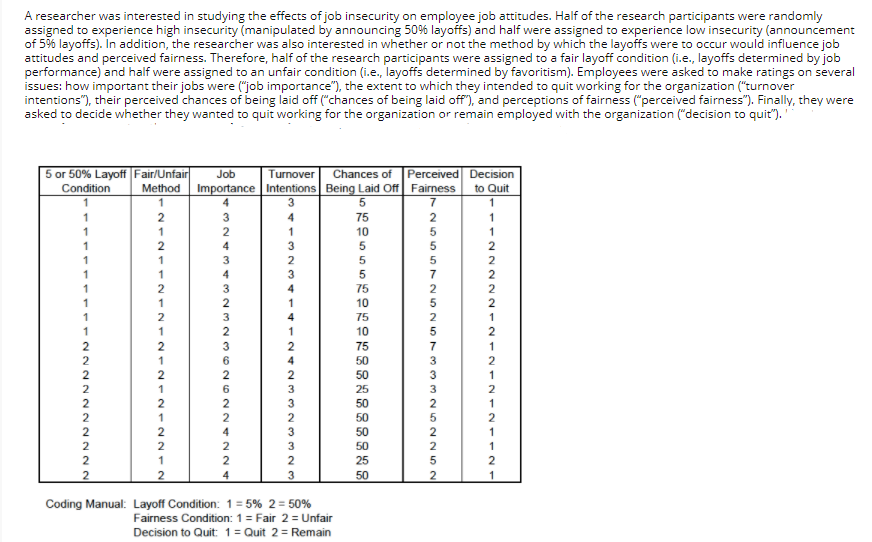Which of the following accurately represents the null and alternative hypothesis? O Hoi p=0 O Hoi p20 Hzip<0 O Ho: p<0 O Hoi pO H1i p =0
Which of the following accurately represents the null and alternative hypothesis? O Hoi p=0 O Hoi p20 Hzip<0 O Ho: p<0 O Hoi pO H1i p =0
Glencoe Algebra 1, Student Edition, 9780079039897, 0079039898, 2018
18th Edition
ISBN:9780079039897
Author:Carter
Publisher:Carter
Chapter4: Equations Of Linear Functions
Section: Chapter Questions
Problem 8SGR
Related questions
Concept explainers
Contingency Table
A contingency table can be defined as the visual representation of the relationship between two or more categorical variables that can be evaluated and registered. It is a categorical version of the scatterplot, which is used to investigate the linear relationship between two variables. A contingency table is indeed a type of frequency distribution table that displays two variables at the same time.
Binomial Distribution
Binomial is an algebraic expression of the sum or the difference of two terms. Before knowing about binomial distribution, we must know about the binomial theorem.
Topic Video
Question
25-

Transcribed Image Text:The researcher hypothesized that there would be a significant correlation between job importance and turnover intentions. Was she correct? Use an
a = .05.
Which of the following accurately represents the null and alternative hypothesis?
O Ho: p=0
O Ho: p20
H1: p<0
O Ho: P<0
H1: p20
O Ho: p+0
Hi: p = 0

Transcribed Image Text:A researcher was interested in studying the effects of job insecurity on employee job attitudes. Half of the research participants were randomly
assigned to experience high insecurity (manipulated by announcing 50% layoffs) and half were assigned to experience low insecurity (announcement
of 5% layoffs). In addition, the researcher was also interested in whether or not the method by which the layoffs were to occur would influence job
attitudes and perceived fairness. Therefore, half of the research participants were assigned to a fair layoff condition (i.e., layoffs determined by job
performance) and half were assigned to an unfair condition (i.e., layoffs determined by favoritism). Employees were asked to make ratings on several
issues: how important their jobs were ("job importance"), the extent to which they intended to quit working for the organization ("turnover
intentions"), their perceived chances of being laid off ("chances of being laid off"), and perceptions of fairness ("perceived fairness"). Finally, they were
asked to decide whether they wanted to quit working for the organization or remain employed with the organization ("decision to quit").'
5 or 50% Layoff Fair/Unfair
Job
Turnover
Chances of Perceived Decision
Condition
Method Importance Intentions Being Laid Off Fairness
to Quit
4
3
7
1
2
3
75
2
1
1
2
10
1
2
4
5
1
1
3
5
2
1
1
4
3
5
7
1
2
3
4
75
2
2
1
2
1
10
2
1
3
4
75
2
1
1
2
10
3
2
75
7
1
1
6.
2
4
50
2
2
2
2
50
1
2
1
6
3
25
3
2
2
2
2
50
1
2
1
2
2
50
2
2
2
4
3
50
2
1
2
2
3
50
1
2
2
25
5
2
2
4
3
50
2
1
Coding Manual: Layoff Condition: 1= 5% 2 = 50%
Fairness Condition: 1 = Fair 2 = Unfair
Decision to Quit: 1= Quit 2= Remain
Expert Solution
This question has been solved!
Explore an expertly crafted, step-by-step solution for a thorough understanding of key concepts.
Step by step
Solved in 2 steps with 1 images

Knowledge Booster
Learn more about
Need a deep-dive on the concept behind this application? Look no further. Learn more about this topic, statistics and related others by exploring similar questions and additional content below.Recommended textbooks for you

Glencoe Algebra 1, Student Edition, 9780079039897…
Algebra
ISBN:
9780079039897
Author:
Carter
Publisher:
McGraw Hill

Glencoe Algebra 1, Student Edition, 9780079039897…
Algebra
ISBN:
9780079039897
Author:
Carter
Publisher:
McGraw Hill